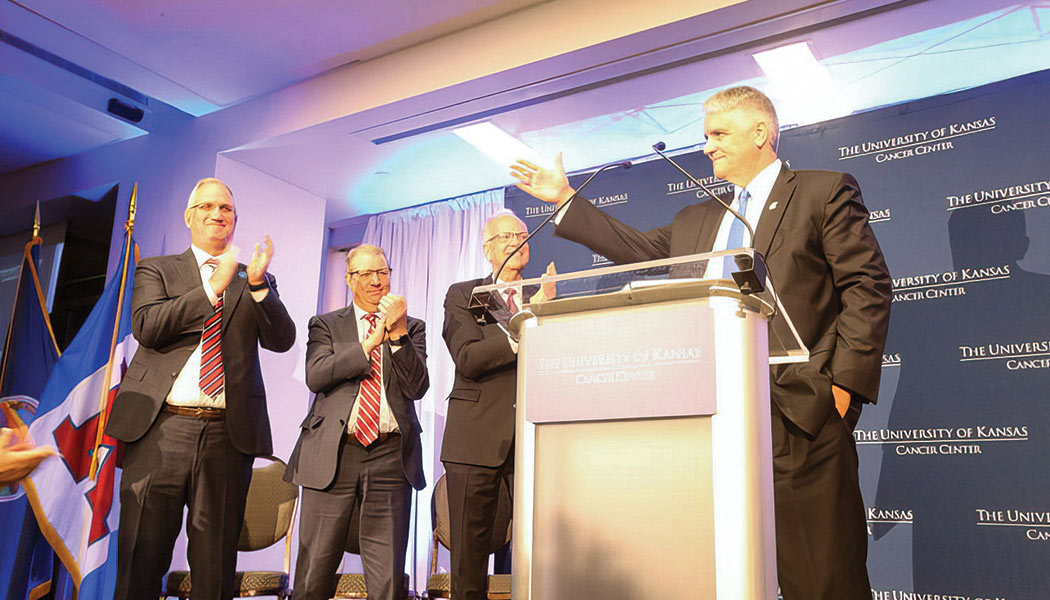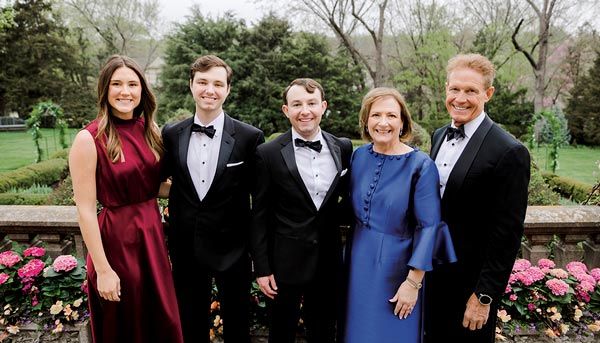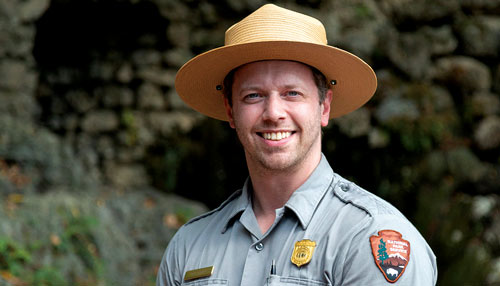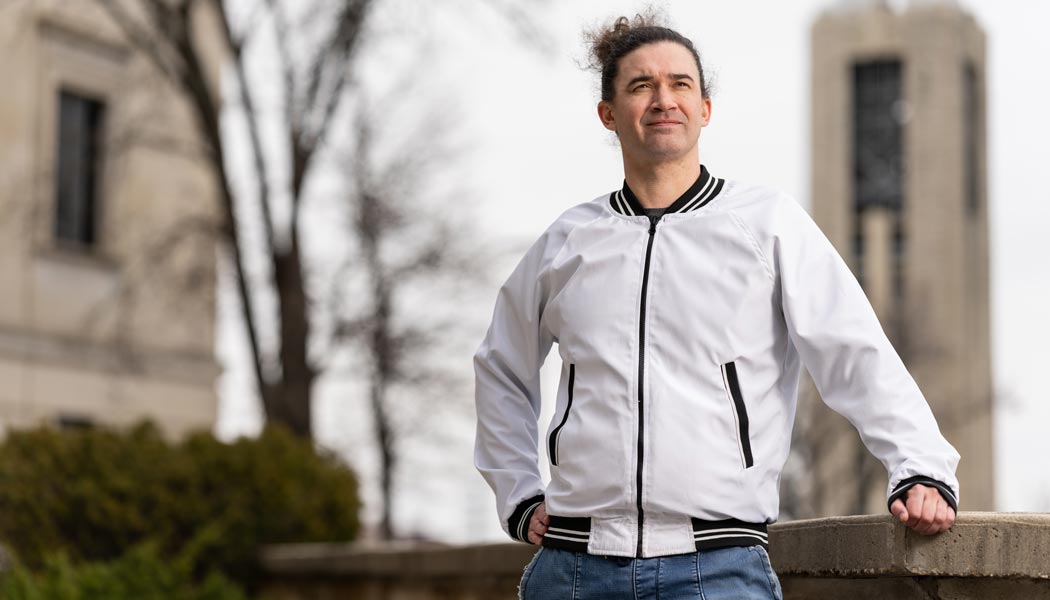Hope on the Horizon

By the time U.S. Sen. Jerry Moran stepped to the microphone July 7 in KU Medical Center’s Robert E. Hemenway Life Sciences Innovation Center, “it doesn’t seem as if there is any surprise left in the room,” he acknowledged, as giddy laughter bubbled through the audience.
Moran, c’76, l’82, soon declared the University’s best worst-kept secret:
“Today, effective July 1, just a few days ago, I’m pleased to announce The University of Kansas Cancer Center has received the National Cancer Institute’s comprehensive designation. Congratulations!”
Jubilant shouts, hugs, handshakes and a standing ovation celebrated KU’s ascent to the pinnacle of cancer research and treatment, and the promise of continued progress to, in the words of Dr. Roy Jensen, the center’s director, “transform the cancer experience” for patients and families throughout the Midwest.
The KU Cancer Center is now one of only 53 NCI comprehensive centers in the nation. Its ambitious mission required nearly two decades of intense work, massive collaboration, mammoth public and private investment, and dogged perseverance to push onward, despite the inevitable setbacks. The achievement is even sweeter considering the longer history of cancer research at KU, which began in the 1970s (see timeline, below).
“This was our moonshot,” Chancellor Doug Girod said July 7, “and today we have landed on the moon.”
Girod recalled the day 10 years ago, when celebrants gathered in the same room on July 12, 2012, to cheer the momentous news that KU had achieved NCI designation, becoming the 67th federally designated cancer center (there are now 71 sites). The milestone was “one of the proudest moments in the history of the University and the region,” Girod said. It signaled a new era of promise for Kansans and residents across the region, who in many cases no longer would need to travel hundreds of miles to take part in the latest clinical trials.
July 12, 2012, also began the second part of KU’s quest: to reach comprehensive NCI status. Although the Cancer Center successfully earned renewal of its designation in 2017, its application for comprehensive designation fell short. As Kansas Alumni reported this spring, Jensen and his team have devoted the past five years to strengthening areas NCI reviewers identified for improvement. These included:
- faculty training
- community outreach and engagement
- clinical research
- geographic consolidation
Last fall, KU submitted its 1,700-page application, and in February an NCI team visited Kansas City and Lawrence (virtually, with the help of The University of Kansas Health System’s sophisticated TV production studio, the site of daily broadcasts during the pandemic).
The progress since 2017 astounded NCI leaders. Moran reported that Dr. Douglas Lowy, the agency’s acting director, told him that, between its first and second bids for comprehensive designation, “KU demonstrated the greatest increase in capabilities, more so than any other applicant they have ever evaluated.”
Along with the comprehensive designation, NCI reviewers bestowed an “outstanding” rating on KU, and the institute awarded a five-year, $13.8 million grant to support cancer research, shared equipment and resources.
According to Jensen, patients treated at NCI-designated centers have a 25% better survival rate. Now that KU has risen to the ranks of comprehensive centers, even more funding, clinical trials and research are on the horizon. Since the NCI review in February, Jensen said, KU already has attracted new experts and leaders in breast cancer, radiation oncology, population health and dermatology. The center’s impressive impact on the region’s economy will continue to grow (see “Cancer Center’s achievement boosts regional economy,” below).
Dr. Rob Simari, Medical Center executive vice chancellor and Franklin E. Murphy Professor of Cardiology, began the July 7 event by noting that the gargantuan effort to lift the Cancer Center also propelled other areas of KU’s research. “It has never been more true that, indeed, rising tides raise all ships,” he said. “With the success of the Cancer Center, centers of excellence in Alzheimer’s disease, kidney disease, diabetes, aging and many others have flourished. And supporting all of these is Frontiers, our clinical and translational science institute. Furthermore, this phenomenon has extended to our basic science and clinical departments, and even to our ability to recruit the best and brightest to Kansas.”
Simari, m’86, who returned to Kansas in 2014 after KU lured him from the Mayo Clinic to lead the School of Medicine as executive dean, invoked his theme of rising tides as he introduced Jensen, the final speaker of the morning: “As we all know, tides are driven by a gravitational pull of the moon. And gravity is the fundamental force of nature. Our rising tide is also driven by a fundamental force of nature, Dr. Roy Jensen.”

As Jensen took his place at the microphone, the crowd burst into another standing ovation. Through the years, many in the room had heard him speak passionately about his personal commitment and his team’s dedication to the mission he accepted in 2004, when KU recruited him from Vanderbilt University: achieving NCI designation and providing the best cancer research and treatment for patients and families whose lives are upended by the dreaded diagnosis.
Since Jensen, an acclaimed breast cancer pathologist, returned to Kansas City, just a few miles north of his boyhood home of Gardner, he has crisscrossed the region as a compelling crusader. His powerful, often emotional messages of hope, along with his gift for demystifying science and his ardent pursuit of the goal, have moved many audiences to tears—and motivated countless allies to contribute to and advocate for the cause. Only Jensen could properly conclude the July announcement with his personal reflections on the hard-won achievement of NCI comprehensive designation.
After asking his team to stand for their well-deserved applause, Jensen listed a few of the Cancer Center’s most remarkable advances:
- In 2004, the center occupied a single wing on KU’s 39th and Rainbow campus and treated 1,700 new patients each year. Today, about 6,500 new patients each year turn to KU for treatment at the Cancer Center’s Fairway headquarters (donated by the Hall Family Foundation)‚ on KU’s 39th and Rainbow campus and at sites across the city, in western Missouri and throughout Kansas.
- In 2012, the center included 108 disease-specific oncologists; now there are more than 150, and the entire center comprises nearly 350 researchers and clinicians. No other institution in the region boasts even one-tenth of that number.
- In 2004, the Cancer Center received about $23 million of total cancer-related research funding. “But I have to tell you that number was about as padded as we could possibly pad it,” Jensen confessed. “There were some grants in there that wouldn’t have cut the mustard these days.” Now the center attracts research investments of nearly $80 million a year.
- KU has greatly expanded its clinical research program, enrolling more than 33,000 participants in clinical trials since 2010. The center now manages about 370 clinical trials.
Both Jensen and Girod credited pivotal boosts that made these improvements possible, beginning with the Kansas Masonic Foundation’s initial investment of $20 million in 2004. The dramatic vote of confidence—and the foundation’s additional support of $10 million—ultimately led to millions more in contributions from other prominent foundations and individual donors through the years. The Cancer Center’s outreach network is now known as the Masonic Cancer Alliance, providing clinical trials and cancer screenings throughout the region.
Kansas leaders and taxpayers also invested in the mission. Five governors, beginning in 2006 with Gov. Kathleen Sebelius, g’70, and numerous advocates in the Kansas Legislature supported annual funding of $5 million from the state budget. In 2020, leaders doubled annual allocation to $10 million.
The most innovative public funding came from Johnson County voters, who in November 2008, despite the dark days of the Great Recession, approved a permanent sales tax to support clinical research (along with growth in teaching and research at the KU Edwards Campus in Overland Park and the Kansas State University Innovation Campus in Olathe). The sales tax helped fund construction of the University of Kansas Clinical Research Center in Fairway, and it now generates $6 million annually for the Cancer Center’s early phase clinical trials program, Jensen said. He thanked the leaders of the distinctive sales tax initiative, known as the Johnson County Education and Research Triangle: Fred Logan, ’74; Mary Birch, j’74; and the late Dick Bond, c’57, l’60. No other NCI-designated center benefits from taxpayers’ ongoing support, Jensen said.
The Cancer Center’s colossal quest also demanded unprecedented collaboration throughout the University and beyond. Jensen cited the vital external partnerships with two pillars of biomedical research and patient care in Kansas City: the Stowers Institute for Medical Research and Children’s Mercy Kansas City.

As Jensen took his place at the microphone, the crowd burst into another standing ovation. Through the years, many in the room had heard him speak passionately about his personal commitment and his team’s dedication to the mission he accepted in 2004, when KU recruited him from Vanderbilt University: achieving NCI designation and providing the best cancer research and treatment for patients and families whose lives are upended by the dreaded diagnosis.
Since Jensen, an acclaimed breast cancer pathologist, returned to Kansas City, just a few miles north of his boyhood home of Gardner, he has crisscrossed the region as a compelling crusader. His powerful, often emotional messages of hope, along with his gift for demystifying science and his ardent pursuit of the goal, have moved many audiences to tears—and motivated countless allies to contribute to and advocate for the cause. Only Jensen could properly conclude the July announcement with his personal reflections on the hard-won achievement of NCI comprehensive designation.
After asking his team to stand for their well-deserved applause, Jensen listed a few of the Cancer Center’s most remarkable advances:
• In 2004, the center occupied a single wing on KU’s 39th and Rainbow campus and treated 1,700 new patients each year. Today, about 6,500 new patients each year turn to KU for treatment at the Cancer Center’s Fairway headquarters (donated by the Hall Family Foundation)‚ on KU’s 39th and Rainbow campus and at sites across the city, in western Missouri and throughout Kansas.
• In 2012, the center included 108 disease-specific oncologists; now there are more than 150, and the entire center comprises nearly 350 researchers and clinicians. No other institution in the region boasts even one-tenth of that number.
• In 2004, the Cancer Center received about $23 million of total cancer-related research funding. “But I have to tell you that number was about as padded as we could possibly pad it,” Jensen confessed. “There were some grants in there that wouldn’t have cut the mustard these days.” Now the center attracts research investments of nearly $80 million a year.
• KU has greatly expanded its clinical research program, enrolling more than 33,000 participants in clinical trials since 2010. The center now manages about 370 clinical trials.
Both Jensen and Girod credited pivotal boosts that made these improvements possible, beginning with the Kansas Masonic Foundation’s initial investment of $20 million in 2004. The dramatic vote of confidence—and the foundation’s additional support of $10 million—ultimately led to millions more in contributions from other prominent foundations and individual donors through the years. The Cancer Center’s outreach network is now known as the Masonic Cancer Alliance, providing clinical trials and cancer screenings throughout the region.
Kansas leaders and taxpayers also invested in the mission. Five governors, beginning in 2006 with Gov. Kathleen Sebelius, g’70, and numerous advocates in the Kansas Legislature supported annual funding of $5 million from the state budget. In 2020, leaders doubled annual allocation to $10 million.
The most innovative public funding came from Johnson County voters, who in November 2008, despite the dark days of the Great Recession, approved a permanent sales tax to support clinical research (along with growth in teaching and research at the KU Edwards Campus in Overland Park and the Kansas State University Innovation Campus in Olathe). The sales tax helped fund construction of the University of Kansas Clinical Research Center in Fairway, and it now generates $6 million annually for the Cancer Center’s early phase clinical trials program, Jensen said. He thanked the leaders of the distinctive sales tax initiative, known as the Johnson County Education and Research Triangle: Fred Logan, ’74; Mary Birch, j’74; and the late Dick Bond, c’57, l’60. No other NCI-designated center benefits from taxpayers’ ongoing support, Jensen said.
The Cancer Center’s colossal quest also demanded unprecedented collaboration throughout the University and beyond. Jensen cited the vital external partnerships with two pillars of biomedical research and patient care in Kansas City: the Stowers Institute for Medical Research and Children’s Mercy Kansas City.
“One out of every two men and one out of every three women will be diagnosed with cancer in our lifetime. And we aim to do nothing less at The University of Kansas Cancer Center than transform the entire cancer experience.”
—Dr. Roy Jensen
Thomas Curran, whom Jensen helped recruit to Kansas City six years ago to lead the Children’s Mercy Research Institute as executive director, shared his perspective on KU’s achievement. Curran described Jensen’s message to him as he considered a move from Philadelphia, where he served as deputy scientific director of the Children’s Hospital of Philadelphia Research Institute from 2006 to 2015.
“Roy shared this ambition and challenge of obtaining comprehensive status. That was actually key for bringing me here to build a research enterprise in Children’s Mercy and a new research building that tightly linked research and medicine,” recalled Curran, who also serves as professor of cancer biology at the KU School of Medicine and professor of pediatrics at the University of Missouri-Kansas City.
Curran, a native of Scotland, confirmed his KC cred by likening Jensen to another local hero: “In this team environment, the quarterback plays a very important role. I don’t know if you realize that nationally, Roy is known as that Patrick Mahomes of cancer research. … The Kansas City region wrote the book on teamwork, and we should take some pride in that.”
The transformation also could not have been possible without the complete metamorphosis of the Cancer Center’s essential clinical partner, The University of Kansas Health System. Jensen thanked system CEO Bob Page and Tammy Mauck Peterman, n’81, g’97, chief operating officer and Kansas City Division president, and the team who led the hospital’s dramatic turnaround over the past 20 years. The KU Health System, including sites in several Kansas communities, now ranks among the nation’s best in patient satisfaction, caring for patients from all 105 counties, all 50 states and several other countries.
Peterman described recent health system milestones that helped propel the Cancer Center. “Just last December,” she said, “we opened the three remaining floors of our Cambridge tower, designed by patients, physicians, nurses and other staff to make sure that we could meet the needs of our hematology patients, our acute leukemia patients and our cellular therapy patients.”
Complementing the new hospital unit are revolutionary treatments the Cancer Center began offering last year, Jensen later explained. In March 2021, KU became the only site in the region to offer new treatments for patients with multiple myeloma, a blood cancer that affects about 30,000 people each year. CAR-T, or chimeric antigen receptor T-cell, is an immunotherapy that trains a patient’s immune system to find and kill cancer cells. Dr. Joseph McGuirk, Schutte-Speas Professor of Hematology-Oncology and division director of hematologic malignancies and cellular therapeutics, leads the program.
“Our Cancer Center can lay claim,” Jensen said, “to putting some of the first patients in the world on the pivotal trials that have led to the U.S. Food and Drug Administration’s approval of various CAR-T therapy vectors that have revolutionized the treatment of acute leukemia lymphoma, Hodgkin’s disease and multiple myeloma.”
Jensen and Peterman also cited the opening in May of the Proton Therapy Center, which features a 747-airliner-sized machine that provides the region’s only precision treatment for patients with certain brain tumors, prostate cancers, and head and neck cancers. Leading the center is Dr. Ronald Chen, c’00, the Cancer Center’s associate director for health equity who also serves as Joe and Jean Brandmeyer Chair and Professor of Radiation Oncology. Chen left Harvard University in 2019 to join KU.
“The Proton Therapy Center will allow patients who maybe previously had traveled for therapy to never have to leave the region to receive the most advanced radiation therapy treatment available anywhere,” Peterman said.
Innovations in proton therapy and immunotherapy—and the NCI comprehensive designation itself—exemplify the advantages of academic medicine, she added. “I often get asked, ‘So what makes academic medicine just a little different?’” she said. “It’s bringing together the strengths of research and education and patient care. It’s that power that comes together to form academic medicine. It’s what’s best for patients.”
The combined enterprise also relies on the steadfast commitment of overall University leaders, said Jensen, who praised the “absolutely consistent, rock-solid” support of chancellors Robert E. Hemenway, Bernadette Gray-Little and Girod—who before succeeding Gray-Little in 2017 led KU Medical Center as executive vice chancellor for four years.
Jensen singled out two early leaders for their vision and courage: Barbara Atkinson, who preceded Girod as the Medical Center’s executive vice chancellor, and Hemenway, who guided KU from 1995 to 2009. As former chancellor, Hemenway celebrated KU’s first NCI designation in 2012; he lost his battle with Parkinson’s disease in 2015.
Jensen recalled that Atkinson had envisioned an NCI-designated cancer center, and she convinced Jensen to come to KU and lead the charge. “I owe her a great deal of gratitude for believing in me and recruiting me,” he said. “While it was Barbara’s vision to make this happen, it still probably would not have taken place without Bob Hemenway,” who in 2006 publicly declared that earning NCI designation was the University’s top priority—a bold gamble. “He had the guts to do it,” Jensen said. “I don’t know that he would have done it if I had told him it might take 20 years. …
“When I think about it, I don’t even know of a place that would decide on a priority and then be willing to spend two decades to make it happen.”
Though Jensen deservedly relishes the achievement of NCI comprehensive designation, he also has set his sights on the next goal. “I have one more thing to ask,” he implored the audience: Imagine the day when the Cancer Center will move from its Fairway headquarters and return north down Rainbow Boulevard, back to the KU campus at 39th Street, where a new, 670,000-square-foot center will consolidate research and treatment programs as the center continues to serve even more families throughout the region.
The new home, Jensen said, “will define our cancer program for the 21st century. … One out of every two men and one out of every three women will be diagnosed with cancer in our lifetime. And we aim to do nothing less at The University of Kansas Cancer Center than transform the entire cancer experience.”
Comprehensive designation will help fulfill that promise, he said, lifting KU to the highest echelon, “where The University of Kansas Cancer Center is one of those centers that is mentioned in the same breath as M.D. Anderson, Memorial Sloan Kettering, Dana Farber—you name the best cancer centers in the country, and that’s our next goal,” he concluded, “because ultimately our real goal is to eliminate this terrible disease from the face of the earth. That’s our dream.
“I hope you’ll join us.”
Thomas Curran, whom Jensen helped recruit to Kansas City six years ago to lead the Children’s Mercy Research Institute as executive director, shared his perspective on KU’s achievement. Curran described Jensen’s message to him as he considered a move from Philadelphia, where he served as deputy scientific director of the Children’s Hospital of Philadelphia Research Institute from 2006 to 2015.
“Roy shared this ambition and challenge of obtaining comprehensive status. That was actually key for bringing me here to build a research enterprise in Children’s Mercy and a new research building that tightly linked research and medicine,” recalled Curran, who also serves as professor of cancer biology at the KU School of Medicine and professor of pediatrics at the University of Missouri-Kansas City.
Curran, a native of Scotland, confirmed his KC cred by likening Jensen to another local hero: “In this team environment, the quarterback plays a very important role. I don’t know if you realize that nationally, Roy is known as that Patrick Mahomes of cancer research. … The Kansas City region wrote the book on teamwork, and we should take some pride in that.”
The transformation also could not have been possible without the complete metamorphosis of the Cancer Center’s essential clinical partner, The University of Kansas Health System. Jensen thanked system CEO Bob Page and Tammy Mauck Peterman, n’81, g’97, chief operating officer and Kansas City Division president, and the team who led the hospital’s dramatic turnaround over the past 20 years. The KU Health System, including sites in several Kansas communities, now ranks among the nation’s best in patient satisfaction, caring for patients from all 105 counties, all 50 states and several other countries.
Peterman described recent health system milestones that helped propel the Cancer Center. “Just last December,” she said, “we opened the three remaining floors of our Cambridge tower, designed by patients, physicians, nurses and other staff to make sure that we could meet the needs of our hematology patients, our acute leukemia patients and our cellular therapy patients.”
Complementing the new hospital unit are revolutionary treatments the Cancer Center began offering last year, Jensen later explained. In March 2021, KU became the only site in the region to offer new treatments for patients with multiple myeloma, a blood cancer that affects about 30,000 people each year. CAR-T, or chimeric antigen receptor T-cell, is an immunotherapy that trains a patient’s immune system to find and kill cancer cells. Dr. Joseph McGuirk, Schutte-Speas Professor of Hematology-Oncology and division director of hematologic malignancies and cellular therapeutics, leads the program.
“Our Cancer Center can lay claim,” Jensen said, “to putting some of the first patients in the world on the pivotal trials that have led to the U.S. Food and Drug Administration’s approval of various CAR-T therapy vectors that have revolutionized the treatment of acute leukemia lymphoma, Hodgkin’s disease and multiple myeloma.”
Jensen and Peterman also cited the opening in May of the Proton Therapy Center, which features a 747-airliner-sized machine that provides the region’s only precision treatment for patients with certain brain tumors, prostate cancers, and head and neck cancers. Leading the center is Dr. Ronald Chen, c’00, the Cancer Center’s associate director for health equity who also serves as Joe and Jean Brandmeyer Chair and Professor of Radiation Oncology. Chen left Harvard University in 2019 to join KU.
“The Proton Therapy Center will allow patients who maybe previously had traveled for therapy to never have to leave the region to receive the most advanced radiation therapy treatment available anywhere,” Peterman said.
Innovations in proton therapy and immunotherapy—and the NCI comprehensive designation itself—exemplify the advantages of academic medicine, she added. “I often get asked, ‘So what makes academic medicine just a little different?’” she said. “It’s bringing together the strengths of research and education and patient care. It’s that power that comes together to form academic medicine. It’s what’s best for patients.”
The combined enterprise also relies on the steadfast commitment of overall University leaders, said Jensen, who praised the “absolutely consistent, rock-solid” support of chancellors Robert E. Hemenway, Bernadette Gray-Little and Girod—who before succeeding Gray-Little in 2017 led KU Medical Center as executive vice chancellor for four years.
Jensen singled out two early leaders for their vision and courage: Barbara Atkinson, who preceded Girod as the Medical Center’s executive vice chancellor, and Hemenway, who guided KU from 1995 to 2009. As former chancellor, Hemenway celebrated KU’s first NCI designation in 2012; he lost his battle with Parkinson’s disease in 2015.
Jensen recalled that Atkinson had envisioned an NCI-designated cancer center, and she convinced Jensen to come to KU and lead the charge. “I owe her a great deal of gratitude for believing in me and recruiting me,” he said. “While it was Barbara’s vision to make this happen, it still probably would not have taken place without Bob Hemenway,” who in 2006 publicly declared that earning NCI designation was the University’s top priority—a bold gamble. “He had the guts to do it,” Jensen said. “I don’t know that he would have done it if I had told him it might take 20 years. …
“When I think about it, I don’t even know of a place that would decide on a priority and then be willing to spend two decades to make it happen.”
Though Jensen deservedly relishes the achievement of NCI comprehensive designation, he also has set his sights on the next goal. “I have one more thing to ask,” he implored the audience: Imagine the day when the Cancer Center will move from its Fairway headquarters and return north down Rainbow Boulevard, back to the KU campus at 39th Street, where a new, 670,000-square-foot center will consolidate research and treatment programs as the center continues to serve even more families throughout the region.
The new home, Jensen said, “will define our cancer program for the 21st century. … One out of every two men and one out of every three women will be diagnosed with cancer in our lifetime. And we aim to do nothing less at The University of Kansas Cancer Center than transform the entire cancer experience.”
Comprehensive designation will help fulfill that promise, he said, lifting KU to the highest echelon, “where The University of Kansas Cancer Center is one of those centers that is mentioned in the same breath as M.D. Anderson, Memorial Sloan Kettering, Dana Farber—you name the best cancer centers in the country, and that’s our next goal,” he concluded, “because ultimately our real goal is to eliminate this terrible disease from the face of the earth. That’s our dream.
“I hope you’ll join us.”
NCI designation: A timeline
1969 KU Medical Center launches cancer program with first professor of clinical oncology.
1970s With National Cancer Institute funding, KUMC investigates feasibility of establishing clinical cancer research center in Kansas.
1990s Cancer Center experiences steady growth in research funding and discoveries.
2002 Cancer Center establishes NCI designation as chief goal.
2004 With $20 million commitment from the Kansas Masonic Foundation, KUMC renames its cancer research organization the Kansas Masonic Cancer Research Institute and recruits nationally recognized researcher Roy Jensen to lead University’s cancer program.
2006 Chancellor Robert E. Hemenway announces that attaining NCI designation is KU’s top research priority. Kansas Legislature approves annual $5 million appropriation for Cancer Center. Drug Discovery, Delivery and Experimental Therapeutics program formed, leveraging world-class cancer biology research at KU, KUMC and the Stowers Institute for Medical Research along with KU School of Pharmacy programs in medicinal and pharmaceutical chemistry.
2007 KUMC launches Midwest Cancer Alliance, a regional network dedicated to research and increased access to clinical trials and cancer care.
2008 Johnson County voters pass an Education and Research Triangle sales tax that funds KU Clinical Research Center, site of Phase I clinical trials. One trial tests Nanotax, a less toxic, more effective chemotherapy drug for ovarian cancer developed at KU. $20 million gift from Annette Bloch benefits cancer services. National Cancer Institute invites KU to apply for NCI designation.
2009 $8.1 million Kauffman Foundation grant (matched by KU Endowment) forms Institute for Advancing Medical Innovation to streamline development of drugs and biomedical devices. Kansas Bioscience Authority awards $29 million to support Cancer Center.
2010 Hall Family Foundation of Kansas City commits $18 million to recruit top scientists and fund Phase I clinical trials facility in Fairway. Researchers advance promising leukemia therapy to Phase I trials. $1 million gift from Burns & McDonnell Foundation launches High-Risk Prostate Cancer Screening Program, and $12 million National Institutes of Health grant funds bid to improve cancer prevention in rural, Latino and American Indian communities in Kansas.
2011 Cancer Center reaches $61 million fundraising goal. The University of Kansas Hospital’s cancer program named one of the nation’s best by U.S. News & World Report. On Sept.19, University submits NCI application.
2012 Kathleen Sebelius, g’80, secretary of U.S. Department of Health and Human Services, formally awards Cancer Center with NCI Cancer Center designation during a July 12 ceremony at the Robert E. Hemenway Life Sciences Center at KUMC.
2016 The Kansas Masons commit $5 million to support the Midwest Cancer Alliance, the Cancer Center’s outreach division, which changes its name to the Masonic Cancer Alliance. Hall Family Foundation commits $8 million to support pursuit of NCI comprehensive designation. In September, Cancer Center submits application for upgraded NCI status.
2017 National Cancer Institute renews the Cancer Center’s NCI designation for another five years but denies the requested upgrade to comprehensive status. Work begins immediately on another application for comprehensive designation.
2018 Cancer Center is recognized as a “high-performing site” by the National Cancer Institute. NCI’s High-Performing Site Initiative recognizes institutions that enroll a large number of patients in National Clinical Trials Network trials while demonstrating scientific leadership in the design and conduct of clinical trials.
2020 The Cancer Center’s status as a community site of the NCI’s Community Oncology Research Program is renewed following a successful first year in which the center’s team exceeds clinical trial accrual goals by more than 22%.
2021 Cancer Center becomes only site in the region to offer CAR-T immunotherapy, and continues construction of Proton Therapy Center, which will enable advanced precision treatment for brain tumors, prostate cancers and head and neck cancers. In September, KU files 1,700-page application for comprehensive designation.
2022 Cancer Center earns NCI’s most prestigious status—comprehensive.
Cancer Center’s achievement boosts regional economy

- Comprehensive designation is expected to create 195 new regional jobs: 89 at KU Cancer Center and 106 across the metro area.
- Since 2007, the quest for NCI designation has resulted in regional economic impact estimated at $2.5 billion, including 4,100 jobs created from 2007 to 2022 and $459 million in federal research funding.
- The additional financial burden of out-of-state treatment has decreased for Kansas families. Before KU Cancer Center’s NCI designation efforts, an estimated 15% of Kansans diagnosed with cancer (about 1,500 annually) left the state for long courses of treatment, meaning expensive travel and lost paychecks for both patients and their family members. Jensen now estimates that within five years, fewer than 5% of Kansans seeking cancer treatment will choose to leave the state.
/




